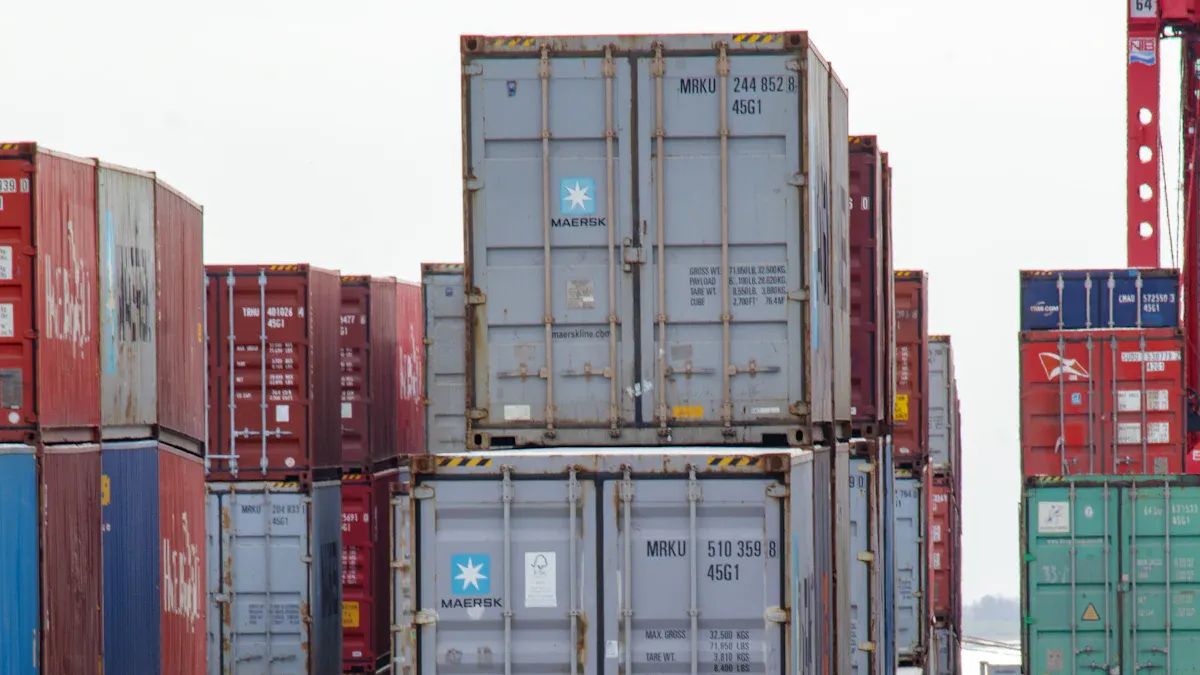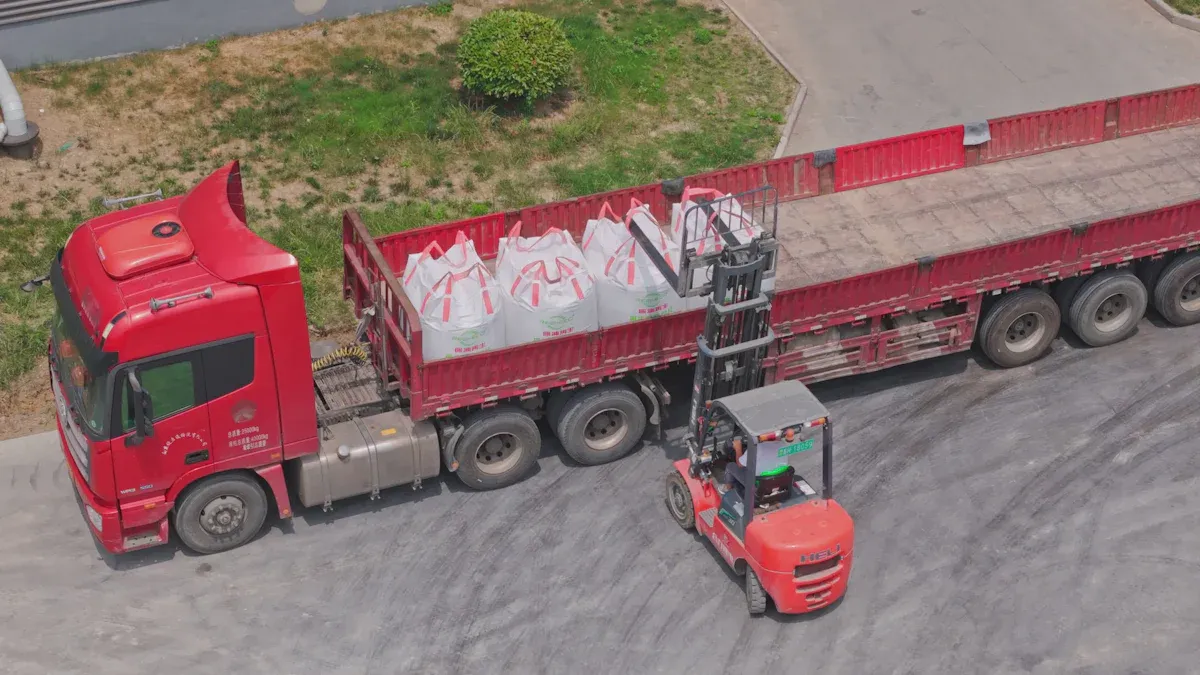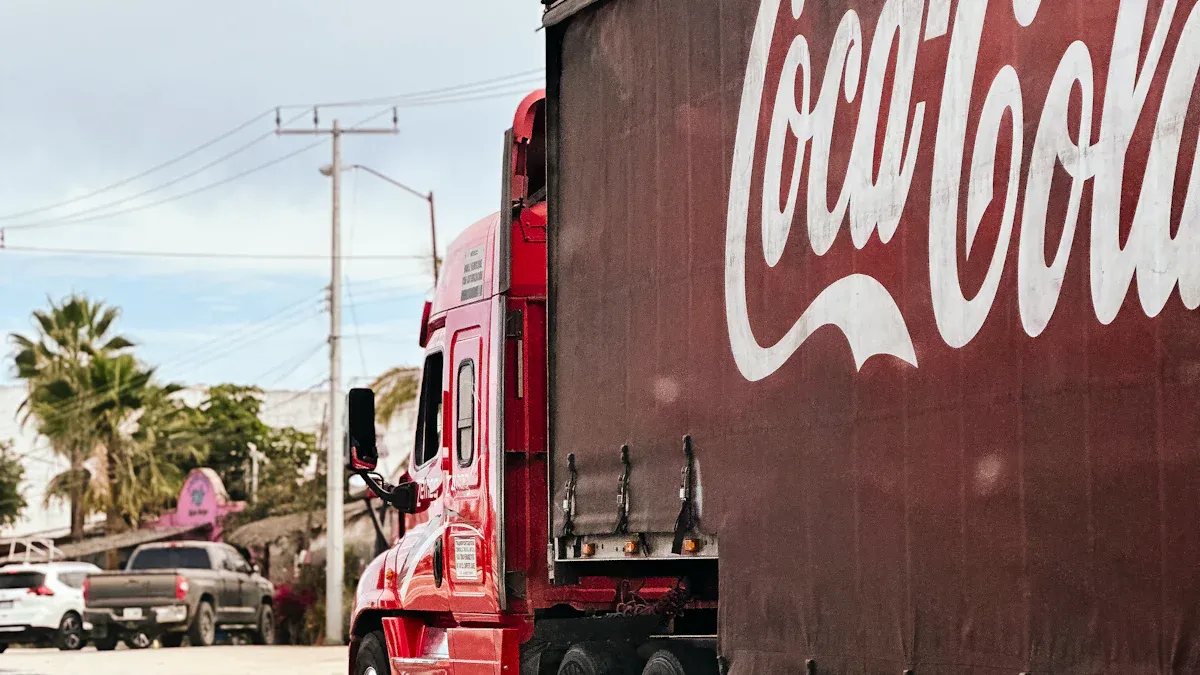What is Less Than Truckload Shipping and How Does It Work in Mexico

Less Than Truckload in Mexico, or LTL shipping, allows you to ship goods without filling an entire truck. Instead of paying for unused space, you share the truck with other shipments. This method benefits businesses that need to move smaller freight volumes. It saves money and avoids the hassle of managing full truckloads.
Small and midsize businesses increasingly rely on LTL shipping. For example, Transfix and Rocket Shipping have partnered to simplify this process. Their collaboration improves pricing and efficiency, making LTL shipping more accessible. In Mexico’s growing logistics industry, this approach helps businesses meet demand while staying cost-effective.
Key Takeaways
LTL shipping lets businesses share truck space to save money. It works well for smaller shipments that don’t need a full truck.
This shipping method is flexible. Businesses can send different shipment sizes based on demand without waiting for a full truck.
LTL shipping helps the environment. Combining shipments means fewer trucks on the road, which saves fuel and cuts pollution.
Picking the right LTL carrier is important. Look at cost, service quality, and areas they cover to ship goods efficiently.
Good packaging and labeling are very important for LTL shipping. They stop damage and delays, making sure items arrive safely and on time.
Understanding Less Than Truckload in Mexico

Definition and core concept of LTL shipping
Less Than Truckload in Mexico refers to a shipping method where your goods share space in a truck with other shipments. Instead of reserving an entire truck for your freight, you only pay for the portion of the truck that your shipment occupies. This approach works well for businesses that need to transport smaller loads but want to avoid the high costs of Full Truckload (FTL) shipping.
LTL shipping operates on the principle of consolidation. Logistics providers group shipments from multiple businesses into one truck. Each shipment has its own destination, but they travel together until they reach a central hub or distribution center. From there, the shipments are sorted and sent to their final destinations. This process ensures that trucks are used efficiently, reducing empty space and lowering costs for everyone involved.
Key features and benefits of LTL shipping
LTL shipping offers several features that make it a practical choice for businesses. First, it provides flexibility. You can ship smaller quantities without waiting to fill an entire truck. Second, it uses a hub-and-spoke model, which allows for efficient routing and delivery. Third, LTL carriers often provide tracking services, so you can monitor your shipment's progress in real time.
The benefits of LTL shipping go beyond cost savings. It helps you reduce waste by optimizing truck space. This makes it an environmentally friendly option. Additionally, it allows you to scale your shipping needs as your business grows. Whether you're shipping a few pallets or a larger load, LTL adapts to your requirements.
How LTL differs from Full Truckload (FTL) shipping
The main difference between LTL and FTL shipping lies in how the truck is used. With FTL, you rent the entire truck for your shipment. This works best for large loads that can fill the truck. In contrast, LTL shipping lets you share the truck with other businesses. This makes it ideal for smaller shipments.
Another key difference is cost. FTL shipping tends to be more expensive because you pay for the entire truck, regardless of how much space your freight occupies. LTL shipping, on the other hand, charges you based on factors like weight, dimensions, and distance. This makes it a more affordable option for businesses with smaller freight volumes.
Finally, the transit time can vary between the two methods. FTL shipments usually travel directly to their destination, resulting in faster delivery. LTL shipments may take longer because they involve multiple stops for unloading and sorting. However, the cost savings and flexibility often outweigh the slightly longer delivery times for many businesses.
How LTL Shipping Works in Mexico
The process of consolidating shipments
Consolidating shipments is the backbone of Less Than Truckload in Mexico. This process involves combining multiple smaller shipments from different businesses into one truck. Each shipment occupies only a portion of the truck's space. Logistics providers group these shipments based on their destinations to maximize efficiency.
When you use LTL shipping, your goods first arrive at a central hub. Here, they are sorted and combined with other shipments heading in the same direction. This method ensures that trucks are fully utilized, reducing empty space and lowering transportation costs. Consolidation also minimizes the environmental impact by decreasing the number of trucks on the road.
For example, if your business needs to ship a few pallets of goods, you don't have to wait until you have enough to fill an entire truck. Instead, your shipment joins others, allowing you to save time and money. This process makes LTL shipping an ideal choice for businesses with smaller freight volumes.
Role of logistics providers and freight carriers
Logistics providers and freight carriers play a crucial role in Less Than Truckload in Mexico. They manage the entire shipping process, from pickup to delivery. Logistics providers focus on planning and coordination. They ensure that shipments are consolidated efficiently and routed through the most effective paths. Freight carriers handle the physical transportation of goods, ensuring they reach their destinations safely.
In Mexico, logistics providers must navigate unique challenges. For intra-Mexico shipping, they need to understand local regulations and customs requirements. For inter-Mexico shipping, which includes cross-border transportation, they must comply with international logistics rules and customs clearance processes. Both types of shipping rely heavily on LTL freight to move smaller cargo loads cost-effectively.
By working with experienced logistics providers, you can ensure that your shipments are handled professionally. They take care of the complexities, allowing you to focus on your business operations. Freight carriers, on the other hand, ensure that your goods are transported securely and on time.
Cost factors in LTL shipping (e.g., weight, distance, freight class)
Several factors influence the cost of Less Than Truckload in Mexico. The weight of your shipment is one of the most significant. Heavier shipments take up more space and require more resources, which increases the cost. Distance also plays a key role. Longer distances result in higher transportation costs due to fuel and labor expenses.
Freight class is another important factor. This classification system considers the type of goods you're shipping, their density, and their value. For example, fragile or high-value items may fall into a higher freight class, leading to increased costs. Properly classifying your shipment ensures accurate pricing and avoids unexpected charges.
To optimize costs, you can focus on efficient packaging. Reducing the size and weight of your shipment can lower expenses. Additionally, working with a reliable logistics provider can help you find the most cost-effective shipping options. By understanding these cost factors, you can make informed decisions and maximize the benefits of LTL shipping.
Domestic and Cross-Border LTL Shipping in Mexico

Overview of domestic LTL shipping
Domestic LTL shipping in Mexico allows you to move smaller shipments efficiently within the country. This method connects businesses to a network of distribution hubs and carriers that specialize in consolidating freight. It works well for companies that need to transport goods between cities or regions without filling an entire truck.
You can benefit from the flexibility of this system. Whether you’re shipping a few pallets or a partial load, LTL carriers ensure your goods reach their destination. The hub-and-spoke model used in domestic LTL shipping optimizes routes, reducing transit times and costs. Additionally, many carriers offer tracking services, so you can monitor your shipment’s progress.
Cross-border logistics between Mexico and the U.S.
Cross-border LTL shipping between Mexico and the U.S. plays a vital role in international trade. This service allows you to transport smaller loads across the border without the expense of a full truckload. Logistics providers coordinate the movement of goods, ensuring compliance with both countries’ regulations.
When shipping cross-border, your freight typically passes through a consolidation hub near the border. From there, it undergoes customs clearance before continuing to its final destination. This process requires careful planning to avoid delays. Partnering with experienced logistics providers can help you navigate the complexities of cross-border shipping.
Customs, regulations, and compliance for cross-border LTL
Customs and regulations are critical aspects of cross-border LTL shipping. You must ensure your shipment complies with both Mexican and U.S. customs requirements. This includes providing accurate documentation, such as commercial invoices, packing lists, and certificates of origin.
Failure to meet these requirements can result in delays or fines. To avoid issues, work with logistics providers familiar with cross-border compliance. They can guide you through the process, ensuring your shipment clears customs smoothly. Proper labeling and packaging also play a role in meeting regulatory standards.
Tip: Always double-check your documentation before shipping. Accurate paperwork can save you time and prevent unexpected costs.
Advantages of Choosing LTL Shipping
Cost-effectiveness for smaller shipments
Shipping smaller loads often feels expensive when you pay for unused truck space. Less Than Truckload in Mexico solves this problem by letting you share truck space with other businesses. You only pay for the portion of the truck your shipment occupies. This approach reduces costs significantly compared to renting an entire truck.
LTL shipping also eliminates the need to wait until you have enough goods to fill a truck. You can ship smaller quantities as needed, which helps you manage cash flow better. For businesses with tight budgets, this cost-effective solution ensures you can meet customer demands without overspending.
Flexibility and scalability for businesses
LTL shipping adapts to your business needs. Whether you ship a few pallets or a larger load, this method scales with your requirements. You don’t need to commit to a full truckload, which gives you more flexibility to adjust your shipping volumes.
This flexibility becomes especially useful during seasonal peaks or unexpected demand surges. You can increase or decrease your shipments without worrying about truck availability. LTL carriers also offer frequent pickups, so you can schedule shipments that align with your operations. This adaptability makes LTL shipping a practical choice for businesses of all sizes.
Environmental benefits of shared transportation
LTL shipping contributes to a greener supply chain. By consolidating shipments, it reduces the number of trucks on the road. Fewer trucks mean lower fuel consumption and reduced greenhouse gas emissions. This shared transportation model optimizes truck space, minimizing waste and promoting sustainability.
Choosing LTL shipping also aligns your business with eco-friendly practices. Customers increasingly value companies that prioritize environmental responsibility. By using LTL, you not only save money but also demonstrate your commitment to reducing your carbon footprint.
Tip: Consider LTL shipping as a way to balance cost savings with environmental impact. It’s a win-win for your business and the planet.
Practical Tips for Businesses Using LTL Shipping
Choosing the right LTL carrier
Selecting the right LTL carrier can make a big difference in your shipping experience. To ensure you choose the best option, consider these key factors:
Cost Efficiency: Compare rates among carriers to find one that fits your budget without compromising quality.
Service Quality: Look for carriers known for timely and reliable deliveries. This ensures your customers receive their orders on time.
Shipping Options: Check if the carrier offers services that match your business needs, such as expedited shipping or temperature-controlled transport.
Geographic Coverage: Confirm the carrier can deliver to all your target locations, both domestically and cross-border.
Scalability and Flexibility: Choose a carrier that can handle your growing shipping demands.
Risk Management: Review the carrier’s liability policies and track record for handling goods safely.
Integration and Technology: Ensure the carrier’s systems work well with your logistics software for seamless operations.
Safety Record: Research the carrier’s compliance with regulations and past safety incidents.
Experience and Expertise: Select a carrier with a strong background in your industry’s shipping requirements.
Customer Service and Communication: Test their responsiveness and ability to provide clear updates.
Tip: Partnering with a reliable carrier improves efficiency and builds trust with your customers.
Best practices for packaging and labeling
Proper packaging and labeling protect your goods during transit and prevent delays. Use sturdy materials like corrugated boxes or pallets to secure your shipment. Wrap fragile items with bubble wrap or foam to avoid damage. Shrink-wrap pallets to keep them stable during transport.
Label your packages clearly with the correct shipping address, contact information, and any special handling instructions. Use barcodes or QR codes for easy tracking. Double-check that all labels are legible and securely attached.
Note: Incorrect or missing labels can lead to lost shipments or delivery delays.
Strategies to optimize costs and delivery times
To save money and improve delivery times, focus on efficient planning. Consolidate shipments whenever possible to reduce costs. Work with your carrier to schedule pickups during off-peak hours, as this may lower fees.
Use accurate weight and dimensions when quoting shipments. Overestimating can increase costs, while underestimating may result in additional charges. Optimize your packaging to minimize wasted space and reduce freight class costs.
Tip: Regularly review your shipping data to identify trends and adjust your strategy for better results.
LTL shipping in Mexico offers significant advantages for businesses. It reduces costs by letting you share trailer space and pay only for what you use. This method works well for shipments under 10,000 pounds, making it ideal for small businesses and e-commerce. Understanding logistics and compliance ensures smooth operations and avoids delays.
Metric | Description |
|---|---|
Cost-Effectiveness | LTL shipping is a cost-effective solution for smaller shipments, allowing businesses to share trailer space and costs. |
Shipment Size | Typically under 10,000 pounds, making it ideal for small businesses and e-commerce merchants. |
Operational Model | Shippers pay for the portion of the trailer their freight occupies, optimizing costs. |
Factors Influencing Costs | Includes freight class, weight, fuel prices, distance, speed, and accessorial fees. |
By choosing LTL shipping, you can scale your operations, save money, and contribute to a sustainable supply chain.
FAQ
What types of goods are best suited for LTL shipping?
LTL shipping works well for smaller shipments like pallets of consumer goods, electronics, or non-perishable items. It’s ideal for freight that doesn’t require a full truckload but still needs secure and efficient transportation.
How do I calculate the cost of LTL shipping?
Costs depend on weight, dimensions, distance, and freight class. Use a freight calculator or consult your logistics provider for an accurate quote. Properly measuring and classifying your shipment ensures you avoid unexpected fees.
Tip: Double-check your shipment’s weight and dimensions to optimize costs.
Can I track my LTL shipment?
Yes, most LTL carriers offer tracking services. You can monitor your shipment’s progress online using a tracking number provided by the carrier. This ensures you stay informed about delivery timelines.
How long does LTL shipping take?
Transit times vary based on distance and the carrier’s route. Domestic shipments within Mexico typically take 2–5 days. Cross-border shipments may take longer due to customs clearance.
What should I do if my shipment gets damaged?
Report damages to the carrier immediately. Document the issue with photos and detailed descriptions. File a claim with the carrier, including all necessary paperwork, to seek compensation.
Note: Proper packaging reduces the risk of damage during transit.
See Also
Exploring LTL Freight Trends: Insights for Tomorrow's Market
Discovering Innovations in Sea Freight Logistics for 2024
Revolutionizing Logistics: JUSDA's Approach to Enhanced Efficiency
Unlocking Efficiency: JUSDA's Innovative Logistics Technology Solutions
Affordable Transportation Management: The Smart Choice for Budgets
